types of cranes
EFI designs and builds the following types of cranes: Single
Girder Cranes, Double Girder Cranes, Jib
Cranes, Wall Traveling Jib Cranes, Truss
Girder Cranes, Gantry Cranes, Monorail
Systems, Load and Beam Rigging and Runway
Systems for the cranes we build.
single girder cranes
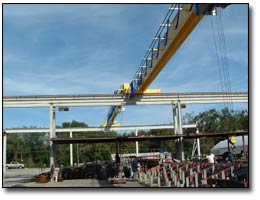 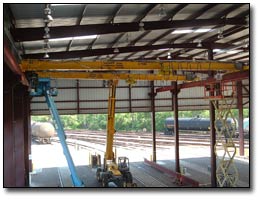
Single Girder Cranes are typically the most economical
choice for light to medium duty bridge cranes. They are available
up to 100’ span
at 10 ton capacity, up to 80’ at 15 ton, up to 60'
at 20 ton. Single girder cranes are available
as both top running, or under running where the crane runway
beams hang from the existing facility overhead structure.
Equipment Fabricators builds nearly 100 single girder cranes
each year.
The advantages of single girder cranes (as compared to double
girder) include economy and slightly lower loads delivered
into the building or foundations.
Some things to consider with single
girder cranes include:
- The
crane main girder is above the hoist, therefore reducing
the available hook height in a given facility.
- The hoist
trolley wheels ride on the relatively soft steel of the
main girder bottom flange, therefore, the life expectancy
of the structural beam is limited.
- The trolley mechanical
components are often less durable when compared to double
girder top running trolleys.
- Special features are often
difficult to incorporate into single girder cranes – i.e.
service walks, lights, fast speeds, heavy service components
etc
Facility designers tip: If you're designing
a new facility, and crane hook height is the primary factor driving the height
of the building, consider going with Double Girder cranes. The double girder
design gives much better hook height. Depending on the size of the building,
the small increase in crane cost may be far less than the cost of a taller
building. Also, a common complaint among crane operators and facility managers
is inadequate crane hook height.
double girder cranes
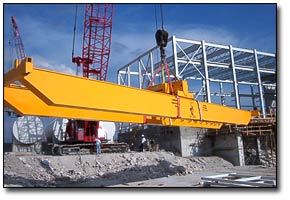 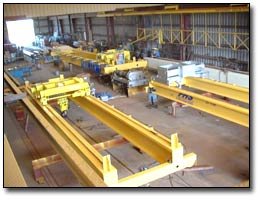
Double Girder Cranes are typically used when the limitations
of single girder cranes are reached. Double Girder cranes
are available up to almost limitless span and capacity.
Additionally, a vast number of special design features
are available. Equipment Fabricators has built these cranes
up to 130’ span and has built major components for
cranes handling up to 600 ton loads.
The advantages of double girder cranes (as compared to single
girder) include:
- Traditionally are more durable than single girder
- Excellent hook height relative to facility overhead
obstructions
- Better serviceability compared to single
girder
- Wide range of special features available: much
higher speeds, maintenance, serviceability and durability
options, and special controls
The disadvantages of
double girder cranes (as compared to single girder)
include:
- Higher initial cost
- Slightly higher loads delivered into facility and/or
foundations
- Slightly reduced end approach due to longer wheel
base endtrucks
jib cranes
Jib Cranes are often a very economical choice when
desired work area is limited. Jib cranes are
commonly available and reasonably priced up to 5 ton x
25' boom length. Jibs are commonly used in smaller work
station applications and are often used for removing boats
from the water where ramps are limited. They are available
with motorized rotation as well manual push/pull rotation.
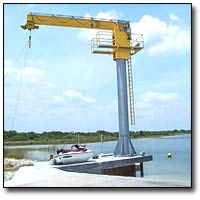
The above pictured EFI built jib crane is used for moving
boats in and out of the water. The waterfront location invoked
a number of special design features including hot dip galvanized
column, sandblast and two coat paint of all other steel,
anti-condensation heaters in all motors and controls, higher
horse power motors due to operations in the wind, and hurricane
tie-downs.
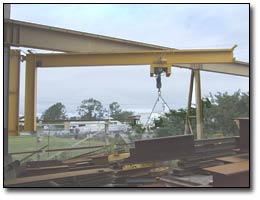
The above pictured EFI built Jib crane is mounted to existing
facility structure. When this approach is considered, thorough
evaluation of the facility structure must be performed.
Facility
designers note: Free Standing Jib cranes require very large and very deep foundations. Down the road, many jib crane purchasers wish they had spent their money on bridge cranes. As their business grows, the hook coverage provided by a jib crane rapidly becomes inadequate; and there is no reasonable way to increase the coverage with a jib.
Jib crane buyers/users
tip: On manually rotated jibs, it is common
for the user to rotate the boom via pulling on the load
or a rope tied to the end of the boom. An alternate method
is to attach a rigid "pole" to the boom coming down
to a convenient height for the operator to push/pull the
boom. A rigid pole allows for much better control of the
boom. The only down side is of course having the pole
in the way at times
wall traveling jib cranes
Wall Traveling Jib Cranes are somewhat rare due to their high initial cost for both the crane, runway system and the cost for facility structural reinforcements. However, when properly applied and used, they offer tremendous benefits to production while causing little interference with other equipment and operations in the facility. The bridge cranes typically pass over the top of wall traveling jibs.
There are a number of manufacturers of light duty wall traveling
jib cranes. Spanco, Gorbel and O-Brien to name a few. EFI
has developed a very heavy duty wall traveling jib that utilizes
swiveling and articulating connections for all major load
carrying wheels. While expensive, our wall traveling jibs
are providing years of heavy service with very little maintenance
long after the other jibs have been taken down and thrown
into the "bone yard".
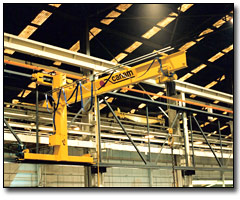
The above pictured EFI designed and built Wall Traveling
Jib is one of 5 units in use by a large fabricating plant.
The jibs serve a dipping tank for trusses as well as fabrication
areas. A number of our jibs are also in use serving production
plate burning lines as well.
Facility
designers note: Wall Traveling Jib cranes invoke substantial loads
into the facility columns and foundations. Planning for these jibs should
come early in the design phase of the facility. Contact EFI for loading conditions.
Scorpion Welding & Workstation
Another application for wall traveling machinery
is EFI's Scorpion Welding and Workstation system. This EFI designed and built
wall traveling work station system eliminates shop floor clutter and damage
to wire feed welders, torch lines, air lines, 110 v power lines etc. The system
puts all (or part of) these utilities up on the swinging and traveling boom
instead of on the floor in harms way.
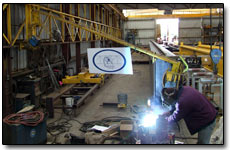 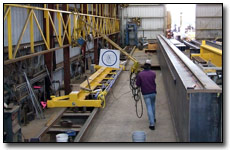 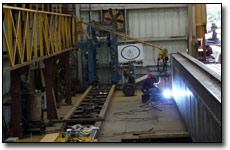
Plant mangers note: Tired of the downtime and cost incurred by replacing welding cables and hoses?
Call EFI to learn more about how the Scorpion can save you $$$ on maintenance
and increase productivity!!
truss girder cranes
Truss Girder Cranes are a variation from the typical beam
or box girder that becomes economical when long crane spans
are required. Additionally, many truss girders allow the
hoist to be located "up into" truss thereby offering much
better hook height than a single beam or box girder crane.
Also, truss girder cranes are typically more economical
than long span beam or box girder cranes. Truss girder
cranes offer almost limitless span - but capacity is often
limited with longer spans. Truss girders are also used
on outdoor long span cranes in order to reduce effects
of wind on the crane drive system.
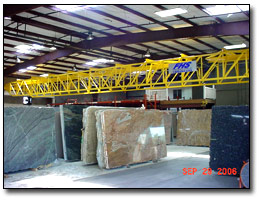 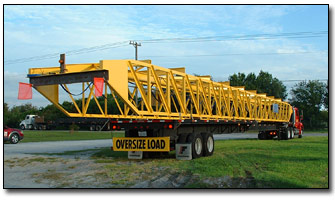
The above pictured EFI designed and built Truss girder
crane spans 92'.
The building was too low for traditional box girder crane
design, so the truss girder was the appropriate choice. In
this particular application, the Truss had to be designed
shallow enough for the marble sheets to stay below the truss
yet high enough get on and off trucks - while in the vertical
position.
gantry cranes
Gantry Cranes offer an economical solution to bridge cranes
when the building is inadequate to support a bridge crane
or the crane system is to be located outdoors.
While Gantries offer significant cost savings, there are
a number of things to consider as well:
- When floor mounted,
the gantry legs will be constantly traveling in the area
of workers – thereby creating
a workplace hazard. Warning bells must be installed to
alert the workers of gantry movement, but after a while,
workers tend to get used to the noise and fail to notice
it. If the noise is too loud, it aggravates the workers
and they disconnect the warning bell: which is even worse!
- Powering the gantry is problematic: cord reels can
be used – but have limited range – and create
a hazard in that it is a high-voltage “extension
cord” on
the ground. Another alternative is a buss bar system running
along the length of the runway, but this is yet another
added cost that is often unanticipated.
- Heavier capacity Gantries must have some type of steel
rail system to ride on – this rail often impedes
forklifts and other equipment.
- Gantries have a relatively high wheel load, which means
the concrete must be quite thick, or strip footers must
be installed.
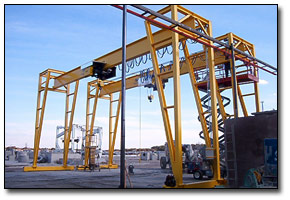
The above pictured pair of 10 ton by 50' span gantries
was designed and built
by EFI to be used in a concrete bucket handling operation.
Notice the substantial bracing used to maintain structural
rigidity.
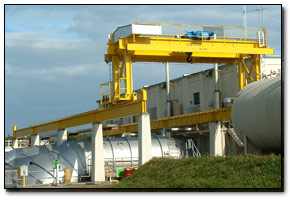
The above pictured Elevated Leg 30 ton x 35' span gantry
was designed and built
by EFI for a South Florida pump station.
These cranes have a full compliment of outdoor service options: Oversized
motors and controls to allow operation in high wind conditions, sandblast and
high performance paint systems, Nema 4X enclosures, galvanized fasteners, space
heaters in motors and controls, hoist covers, motor covers etc.
Gantry crane buyers note: Gantries are
commonly used outdoors. Without proper design and manufacturing, outdoor electric
cranes are very susceptible to water related problems. EFI suggests you clearly
understand the outdoor service options and costs offered by your crane builder(s).
Outdoor service options are expensive - but it is definitely
a "pay me now or pay me later" situation.
monorail systems
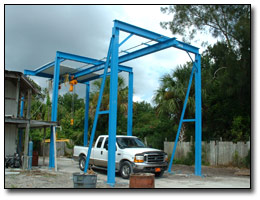
Monorails can either be designed as self-supported (as
shown in picture above) or supported by existing
facility overhead steel. Capacity is limited, up to about
20 tons in most cases. Lengths of the rail are almost limitless.
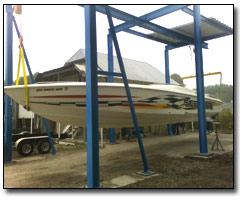
The above pictured EFI designed and built monorail
system is used to service boats. Here again, the outdoor
service caused the customer to require a high-performance
paint system.
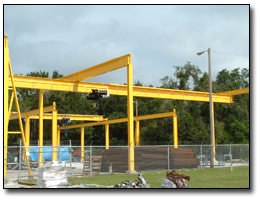
The above pictured EFI designed and built
monorail system is used in conjunction with a free-standing
bridge crane system in a re-bar fabrication yard.
load beams & rigging
Once the appropriate crane is in place, connecting it
to the load must then be considered. A set of chains or
chokers often doesn’t work correctly. Appropriate
selection of rigging, spreader beams and other under-hook
devices is critical to safe and productive use of cranes.
EFI has built a number of special below the hook devices.
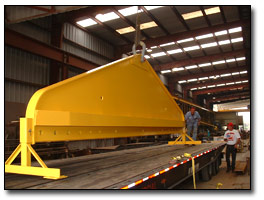
The above pictured EFI designed and built load
beam is 23’ long
rated at 150 tons.
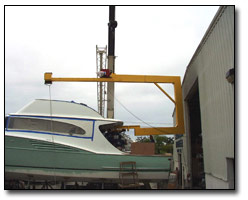
The above pictured very unique load beam was designed
and built by EFI to provide a method for a boat manufacturer
to install the motors – after the boat was nearly
complete. The load beam features a movable counterweight
and an electric winch to lower the motor into position.
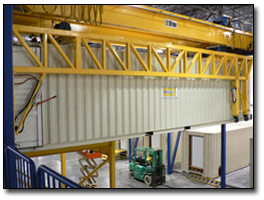
The above pictured specialized load beam arrangement was
designed by one of EFI’s distributors, Royce Crane
of Atlanta. EFI built the crane and load beam system for
Royce Crane. The System is used to store and retrieve.
Plant
mangers note: Improper rigging
is the NUMBER ONE cause of accidents
when using overhead cranes. We suggest
that you develop a thorough knowledge
of rigging and then get your workers
trained just as well! Additionally,
there are many, many below the hook
devices that can make your crane
operations safer and also much more
productive. We suggest a thorough
review of the Caldwell Co. catalogue
to learn all you can about the numerous
devices available.
crane runway systems
The importance of proper crane runway system design, fabrication
and installation is critical to the durability and life span
of the crane system. EFI builds runway systems for most
of our cranes. Our shop’s
crane builders implement the same exacting standards for
accuracy and workmanship on the runways as they do the cranes.
Many runway systems are built by “red-iron" shops and
are un-aware of the importance of the runways.
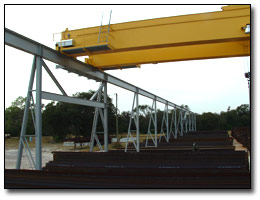
The above pictured EFI designed and built 25’ tall freestanding
A-frame runway system sees column loads in the area of 100,000#,
3 shifts per day, 5 days per week. All steel is shot blasted,
epoxy primered and top-coated with Alkyd Enamel. Additionally,
all un-welded joints are caulked with polyurethane caulk.
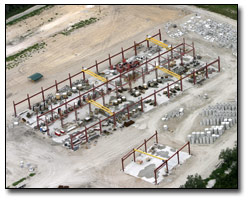
The above pictured EFI designed and built 30’ tall freestanding
runway system is ready to have the roof installed. The facility
features 60,000 sf of floor space. All steel is shot blasted
and epoxy primered.
|
